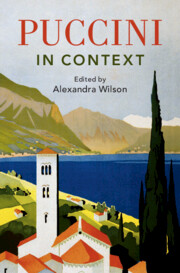Book contents
- Puccini in Context
- Composers in Context
- Puccini in Context
- Copyright page
- Contents
- Figures
- Table
- Notes on Contributors
- Preface
- Part I Formative Influences
- Part II Puccini’s Places
- Part III Influences and Interests
- Part IV Bringing Puccini to the Stage
- Part V Image and Reputation
- Part VI Puccini through a Political Lens
- Part VII Interpreting Puccini
- Chapter 26 Editing Puccini
- Chapter 27 Puccini on Video
- Chapter 28 Interpreting Puccini on Stage and on Disc
- Chapter 29 Producing Puccini Today
- Part VIII Legacy
- Bibliography
- Index
Chapter 27 - Puccini on Video
from Part VII - Interpreting Puccini
Published online by Cambridge University Press: 31 August 2023
- Puccini in Context
- Composers in Context
- Puccini in Context
- Copyright page
- Contents
- Figures
- Table
- Notes on Contributors
- Preface
- Part I Formative Influences
- Part II Puccini’s Places
- Part III Influences and Interests
- Part IV Bringing Puccini to the Stage
- Part V Image and Reputation
- Part VI Puccini through a Political Lens
- Part VII Interpreting Puccini
- Chapter 26 Editing Puccini
- Chapter 27 Puccini on Video
- Chapter 28 Interpreting Puccini on Stage and on Disc
- Chapter 29 Producing Puccini Today
- Part VIII Legacy
- Bibliography
- Index
Summary
This chapter examines the topic of Puccini on video – the composer’s appearances as a character in narrative films or television dramas, and versions of his operas conceived expressly for film or television, starting from the arrival of sound cinema. Puccini started being fictionalised as a film character from the 1950s. Detailed attention is paid to Carmine Gallone’s biopic Giacomo Puccini of 1952, a film which takes considerable liberties with historical facts, and the same director’s Casa Ricordi, about the composer’s publishing house. The discussion then moves to the 1980s, to consider Tony Palmer’s Puccini, and to the 2000s, to discuss Paolo Benvenuti’s Puccini e la fanciulla, both of which home in on the Doria Manfredi scandal. The author then discusses transferrals to video of Puccini’s operas, concentrating particularly on Tosca and examining films from the 1940s onwards. Particular attention is paid to a filmed version by Gallone, to the same director’s Avanti a lui tremava tutta Roma, and to a series of slightly later film versions made especially for Italian television during the 1960s and 70s. A 2001 film of Tosca by Benoît Jacquot concludes the survey, chosen because it interrogates the tension between televisual or filmic authenticity and operatic artificiality.
- Type
- Chapter
- Information
- Puccini in Context , pp. 224 - 229Publisher: Cambridge University PressPrint publication year: 2023

